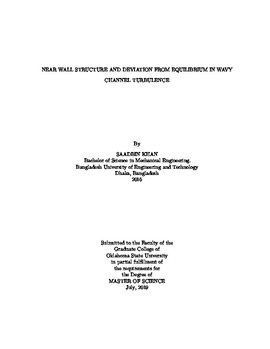| dc.contributor.advisor | Jayaraman, Balaji | |
| dc.contributor.author | Khan, Saadbin | |
| dc.date.accessioned | 2020-01-30T19:46:42Z | |
| dc.date.available | 2020-01-30T19:46:42Z | |
| dc.date.issued | 2019-07 | |
| dc.identifier.uri | https://hdl.handle.net/11244/323408 | |
| dc.description.abstract | The structure of turbulent flow over non-flat surfaces is a topic of major interest in practical applications in both engineering and geophysical settings. A lot of work has been done in the fully rough regime at high Reynolds numbers where the effect on the outer layer turbulence structure and the resulting friction drag is well documented. It turns out that surface topology plays a significant role on the flow drag especially in the transitional roughness regime and therefore, is hard to characterize. Survey of literature shows that roughness function depends on the interaction of roughness height, flow Reynolds number and topology shape. In addition, if the surface topology contains large enough scales then it can impact the outer layer dynamics and in turn modulate the total frictional force. Therefore, it is important to understand the mechanisms underlying drag increase from systematically varied surface undulations in order to better interpret quantifications based on mean statistics such as roughness function. In this study, we explore the mechanisms that modulate the turbulence structure over a two-dimensional (2D) sinusoidal wavy surface with a fixed amplitude, but varying slope. To accomplish this, we model the turbulent flow between two infinitely wide 2D wavy plates at a bulk Reynolds number, $Re_{b}=2800$. We pursue two different but related flavors of analysis. The first one focuses on understanding the non-equilibrium near surface turbulence structure and the second one adopts a roughness characterization of such wavy surfaces. Analysis of the different statistical quantifications show strong dependence on wave slope for the roughness function indicating drag increase due to enhanced turbulent stresses resulting from increased production of vertical velocity variance from the surface undulations. Also, pronounced asymmetry is reported when comparing the turbulence structure on the upstream and downstream region of the wave. | |
| dc.format | application/pdf | |
| dc.language | en_US | |
| dc.rights | Copyright is held by the author who has granted the Oklahoma State University Library the non-exclusive right to share this material in its institutional repository. Contact Digital Library Services at lib-dls@okstate.edu or 405-744-9161 for the permission policy on the use, reproduction or distribution of this material. | |
| dc.title | Near Wall Structure and Deviation from Equilibrium in Wavy Channel Turbulence | |
| dc.contributor.committeeMember | Jacob, Jamey | |
| dc.contributor.committeeMember | San, Omer | |
| osu.filename | Khan_okstate_0664M_16417.pdf | |
| osu.accesstype | Open Access | |
| dc.type.genre | Thesis | |
| dc.type.material | Text | |
| dc.subject.keywords | direct numerical simulation | |
| dc.subject.keywords | roughness | |
| dc.subject.keywords | wall turbulence | |
| dc.subject.keywords | wavy surface | |
| thesis.degree.discipline | Mechanical and Aerospace Engineering | |
| thesis.degree.grantor | Oklahoma State University | |
